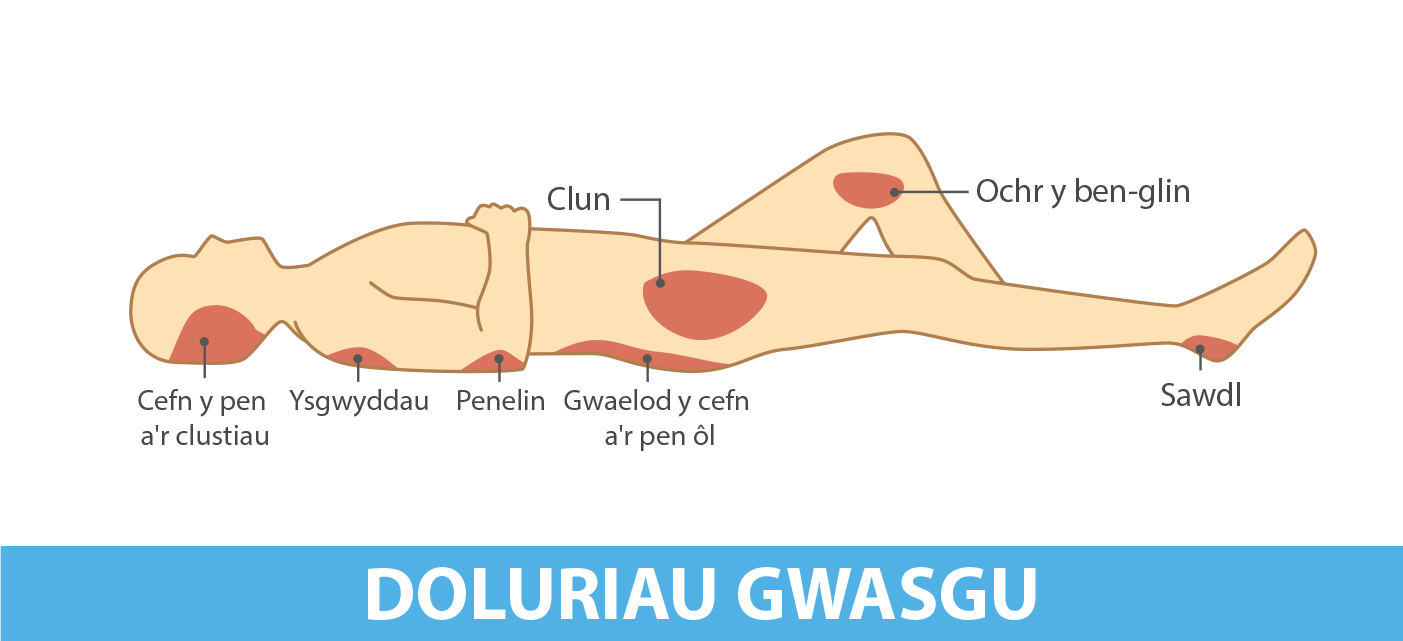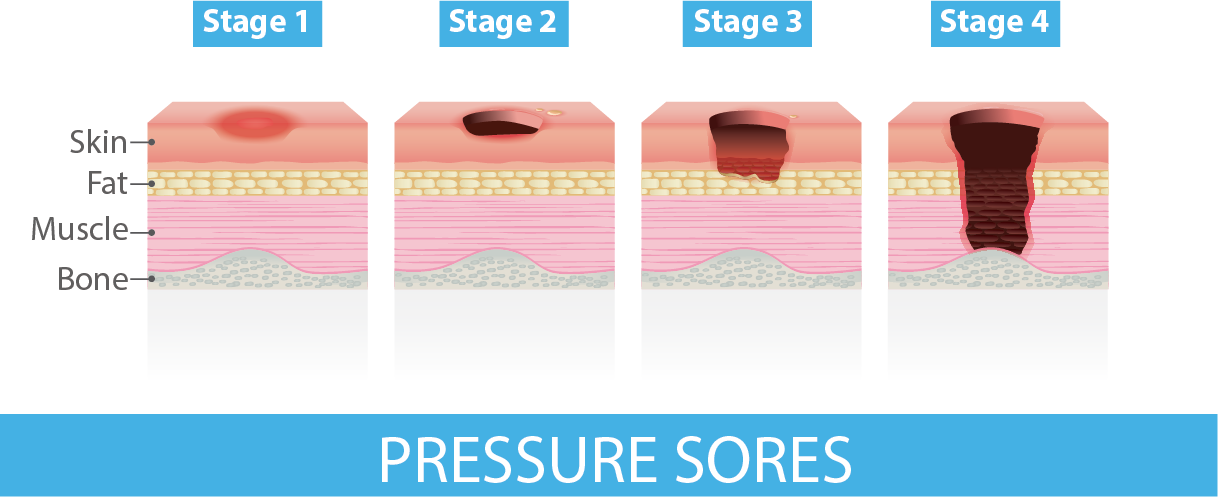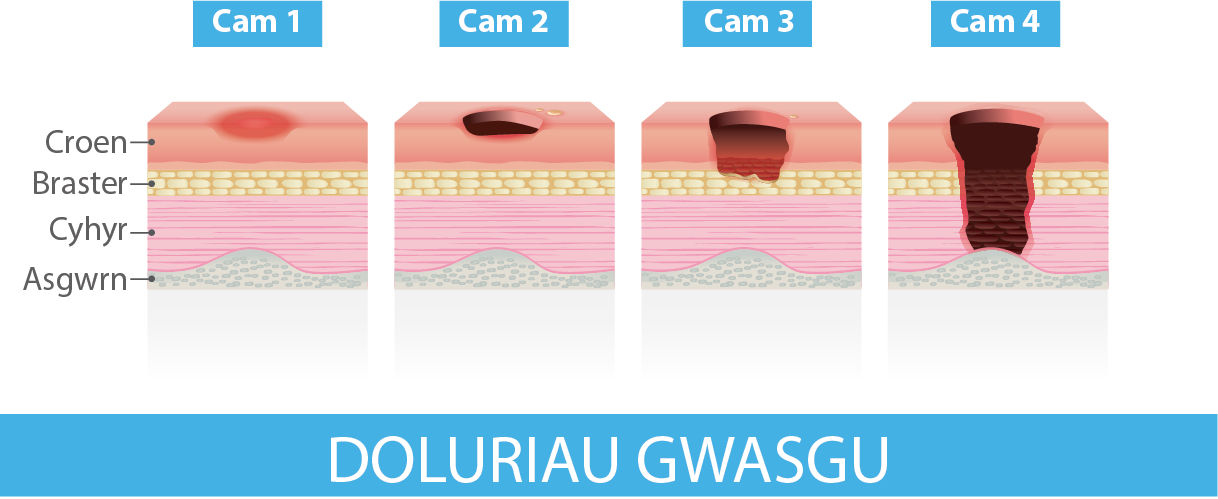




Pressure ulcers are areas of the skin and underlying tissue that are sore or damaged as a result of constant pressure or fiction.
Pressure ulcers develop when pressure or friction is applied to the skin and underlying soft tissue closes or damages capillary, venous or lymphatic networks. Cells around closed vessels die and cause damage. Bony areas of the body are most susceptible to pressure damage. Eventually this can lead to deep tissue damage and necrosis. Pressure ulcers can have a negative impact on an individual’s quality of life. Neglecting a pressure ulcer can cause infection, severe pain and the need for surgery.
Pressure damage is caused by:
With good pressure area care most pressure ulcers can be avoided. This can be by changes of position, checking skin for signs of ulcers, a healthy balanced diet and not smoking.
Risk assessments by the healthcare team reduce the occurrence of pressure ulcers.
Further information and guidance can be found here: http://www.welshwoundnetwork.org/en/news/latest-news/new-pressure-ulcer-guidance-documents-nhs-wales/

Ystyr briwiau pwyso yw rhannau o'r croen a'r meinweoedd oddi tano sy'n ddolurus neu wedi'u niweidio o ganlyniad i bwyso neu ffrithiant parhaus.
Bydd briwiau pwyso'n datblygu pan fydd pwysau neu ffrithiant ar y croen ac mae'r meinweoedd meddal oddi tano yn cau neu'n niweidio rhwydweithiau capilarïaidd, gwythiennol neu lymffatig. Bydd celloedd o gwmpas pibellau gwaed sydd wedi cau yn marw ac yn achosi niwed. Rhannau esgyrnog o'r corff sy'n fwyaf tueddol o ddioddef niwed pwyso. Yn y pen draw, gall hyn arwain at niwed i feinweoedd dwfn a necrosis. Gall briwiau pwyso gael effaith negyddol ar ansawdd bywyd unigolyn. Gall esgeuluso briw pwyso arwain at haint, poen difrifol a'r angen am lawdriniaeth.
Caiff niwed pwyso ei achosi gan:
Gellir osgoi'r rhan fwyaf o friwiau pwyso drwy ofalu am fannau pwyso yn dda. Gellir gwneud hyn drwy newid safle, chwilio am arwyddion o friwiau ar y croen, deiet cytbwys ac iach a pheidio ag ysmygu.
Mae asesiadau risg gan y tîm gofal iechyd yn golygu bod llai o friwiau pwyso'n digwydd.
Mae rhagor o wybodaeth a chanllawiau ar gael yma: http://www.welshwoundnetwork.org/en/news/latest-news/new-pressure-ulcer-guidance-documents-nhs-wales/

There are pieces of legislation and guidelines in place to ensure that individuals involved in the care of vulnerable adults and children know how to minimise the risk of pressure damage, and how to treat the damage if it does occur.
NHS Wales Health and Care Standards, Standard 2.2 Preventing Pressure and Tissue Damage
This standard is about minimising the risk of people developing avoidable pressure ulcers. Pressure ulcers are one of the most frequently reported adult in-patient forms of clinical harm. An assessment of the range of factors which are known to increase risk of developing pressure ulcers is important in developing a plan of care which aims to minimise the risk of individuals developing pressure ulcers.
http://www.wales.nhs.uk/governance-emanual/health-and-care-standards-supporting-gui-5
Pressure Ulcer Reporting and Investigation (All Wales Guidance) 2018
This document:
Essential Elements of Pressure Ulcer Prevention & Management
This guideline facilitates the introduction of and adherence to clinical guidelines that outline optimal strategies for the prevention and treatment of pressure ulcers through its introduction into local policies and guidelines and evidence-based care planning.
NICE guidelines
This guideline covers risk assessment, prevention and treatment in children, young people and adults at risk of, or who have, a pressure ulcer.
https://www.nice.org.uk/guidance/cg179
European Pressure Ulcer Advisory Panel
The panel’s goal is to provide relief for persons suffering from, or at risk of, pressure ulcers, through research and the education of the public and by influencing pressure ulcer policy in all European countries towards an adequate patient centred and cost effective pressure ulcer care.
Mae deddfwriaeth a chanllawiau ar waith er mwyn sicrhau bod unigolion sy'n ymwneud â gofal oedolion agored i niwed a phlant yn gwybod sut i leihau'r risg o niwed pwyso cymaint â phosibl, a sut i drin y niwed os bydd yn digwydd.
Safonau Iechyd a Gofal GIG Cymru, Safon 2.2. Atal Briwiau Pwysau a Niwed i Feinweoedd
Nod y safon hon yw sicrhau cyn lleied â phosibl o risg y bydd pobl yn datblygu briwiau pwyso y gellir eu hosgoi. Briwiau pwyso yw un o'r mathau o niwed clinigol y rhoddir gwybod amdanynt amlaf gan oedolion sy'n gleifion mewnol. Mae'n bwysig asesu'r amrywiaeth o ffactorau y gwyddys eu bod yn cynyddu'r risg o ddatblygu briwiau pwyso wrth lunio cynllun gofal sydd â'r nod o sicrhau cyn lleied â phosibl o risg y bydd unigolion yn datblygu briwiau pwyso.
http://www.wales.nhs.uk/governance-emanual/health-and-care-standards-supporting-gui-5
Rhoi Gwybod am Friwiau Pwyso ac Ymchwilio Iddynt (Canllawiau Cymru Gyfan) 2018
Mae'r ddogfen hon:
Elfennau Hanfodol ar Atal a Rheoli Briwiau Pwyso
Mae'r canllaw hwn yn hwyluso'r broses o gyflwyno a dilyn canllawiau clinigol sy'n amlinellu'r strategaethau gorau posibl ar gyfer atal a thrin briwiau pwyso drwy ei gynnwys mewn polisïau a chanllawiau lleol a gwaith cynllunio gofal sy'n seiliedig ar dystiolaeth.
Canllawiau NICE
Mae'r canllawiau hyn yn cwmpasu asesiadau risg, atal a thrin briwiau pwyso ymhlith plant, pobl ifanc ac oedolion sy'n wynebu risg o gael briwiau pwyso neu sydd â briwiau pwyso eisoes.
https://www.nice.org.uk/guidance/cg179
Panel Ymgynghori Ewrop ar Friwiau Pwyso
Nod y panel yw rhoi cymorth i bobl sy'n dioddef o friwiau pwyso, neu sy'n wynebu risg o ddioddef ohonynt, drwy ymchwil ac addysgu'r cyhoedd, yn ogystal â dylanwadu ar bolisi mewn perthynas â briwiau pwyso ym mhob un o wledydd Ewrop er mwyn sicrhau gofal briwiau pwyso digonol sy'n canolbwyntio ar gleifion ac yn gosteffeithiol.
A number of factors can cause skin breakdown and pressure damage:
Gall nifer o ffactorau wneud i'r croen dorri ac achosi niwed pwyso:

There are four main stages to the development of pressure ulcers.
Stage 1: Closed wounds. Skin is painful but there are no breaks or tears. The skin is reddened and does not lose colour if a finger is pressed on it. Skin temperature is warmer. A stage 1 sore may go in 2-3 days.
Stage 2: Skin breaks away and forms an ulcer. The sore expands into deeper layers of the skin and looks like a crater, abrasion or blister. At this stage some skin may be damaged beyond repair or die. Stage 2 ulcers can heal within 1-6 weeks.
Stage 3: Sore gets worse and extends into tissue beneath the skin and forms a small crater. Fat may be visible in the sore but not muscle, tendon or bone. Stage 3 ulcers may take several months to heal or may never heal especially in those with ongoing health problems.
Stage 4: The wound is deep and reaches into muscle and bone and causes damage. There may be damage to deeper tissues, tendons and joints. Dead tissue may need to be removed to minimise further infection. Stage 4 ulcers may take several months to heal or may never heal especially in those with ongoing health problems.
In stages 3 and 4, tissue damage may mean there is little pain. If injuries progress there can be serious complications e.g. infection of the bone (osteomyelitis) or blood (sepsis).

Mae pedwar prif gam yn y broses o ddatblygu briwiau pwyso.
Cam 1: Clwyfau caeedig. Mae'r croen yn boenus ond nid oes toriadau na rhwygiadau. Mae'r croen yn goch ac nid yw'n colli lliw os caiff ei wasgu â bys. Mae tymheredd y croen yn gynhesach. Gall dolur cam 1 ddiflannu mewn 2-3 diwrnod.
Cam 2: Mae'r croen yn torri i ffwrdd ac yn ffurfio briw. Mae'r dolur yn ehangu i haenau dyfnach y croen ac yn edrych fel crater, crafiad neu bothell. Ar y cam hwn, gall rhywfaint o'r croen gael ei niweidio y tu hwnt i'w adfer neu farw. Gall briwiau cam 2 wella o fewn 1-6 wythnos.
Cam 3: Bydd y dolur yn gwaethygu ac yn ymestyn i mewn i'r feinwe o dan y croen gan ffurfio crater bach. Gall braster fod yn weladwy yn y dolur, ond nid cyhyr, tendon nac asgwrn. Gall briwiau cam 3 gymryd sawl mis i wella neu efallai na fyddant byth yn gwella, yn enwedig i bobl â phroblemau iechyd parhaus.
Cam 4: Mae'r clwyf yn ddwfn ac yn cyrraedd cyhyrau ac esgyrn ac yn achosi niwed. Gall fod niwed i feinweoedd dyfnach, tendonau a chymalau. Gall fod angen cael gwared ar feinwe wedi'i niweidio er mwyn atal unrhyw haint pellach. Gall briwiau cam 4 gymryd sawl mis i wella neu efallai na fyddant byth yn gwella, yn enwedig i bobl â phroblemau iechyd parhaus.
Ar gamau 3 a 4, gall niwed i feinweoedd olygu nad oes llawer o boen. Os bydd yr anafiadau'n gwaethygu, gall hynny arwain at gymhlethdodau difrifol, e.e. haint yn yr asgwrn (osteomyelitis) neu'r gwaed (sepsis).
Drag the signs and symptoms of each of the four stages of pressure ulcer development into the correct columns
Llusgwch arwyddion a symptomau pob un o bedwar cam datblygu briwiau pwyso i'r colofnau cywir
What areas of the body are most commonly affected by pressure damage? Drag the areas of the body to the correct columns
Pa rannau o'r corff y mae niwed pwyso yn effeithio arnynt yn rheolaidd? Llusgwch y rhannau o'r corff i'r colofnau cywir